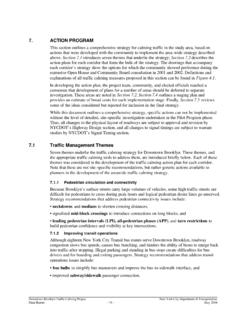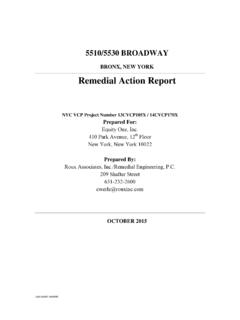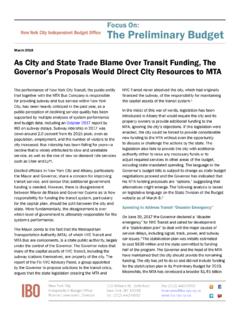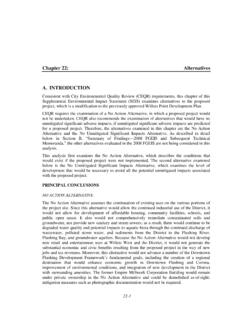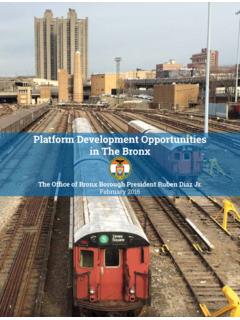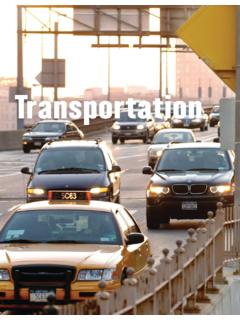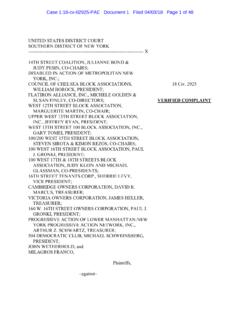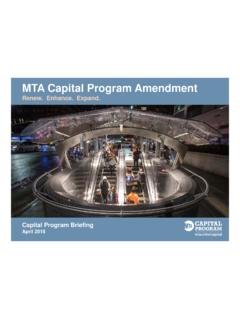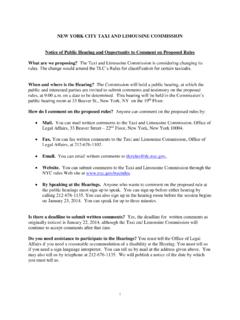Transcription of Review of the Financial Plan of the City of New York ...
1 Review of the Financial plan of the city of New york Report 11-2018 Kenneth B. Bleiwas, Deputy Comptroller March 2018 Message from the Comptroller March 2018 As the State s chief Financial officer, I have a constitutional and statutory responsibility to monitor the finances of the city of New york . This report discusses the economic, fiscal and social challenges facing New york city in an effort to promote an informed discussion. I encourage every city stakeholder to learn more about these issues and to participate fully in the public debate. Thomas P. DiNapoli State Comptroller Contents 1 I. Executive Summary .. 3 II. Changes Since the Beginning of the Fiscal Year.
2 7 III. Federal and State Issues .. 8 IV. Revenue Trends .. 11 V. Expenditure Trends .. 15 VI. Health and Hospitals Corporation .. 22 2 I. Executive Summary 3 New york city s economy is strong and continues to post solid job gains. It added 715,000 jobs between 2009 and 2017, making this the largest and longest job expansion in the post World War II period. After adding 81,000 jobs in 2017, employment reached million, 615,000 more than the prerecession peak. More jobs were added in the boroughs outside of Manhattan than in any other expansion. With record job growth, the unemployment rate has declined from a recessionary peak of percent to percent in 2017, the lowest level in 41 years.
3 The city is on pace for continued job gains in 2018, although growth is expected to slow for the fourth consecutive year as the labor market tightens. Recent gyrations in the stock market have raised concerns about renewed market volatility, which had been absent for years. In addition, inflation and interest rates are now rising after an extended period when both were historically low. Some economists are concerned that the economy may overheat in response to federal tax cuts and higher federal spending. The Mayor s preliminary executive budget for FY 2019 and the associated Financial plan ( the February plan ; see Figure 1) assumes continued economic growth and a short-term boost from higher capital gains and bonuses.
4 The February plan projects a surplus of $ billion in FY 2018 (the city ended FY 2017 with a surplus of $ billion), which will be used to balance the FY 2019 budget. The surplus results largely from a reduction in unneeded reserves and a citywide savings program. The February plan projects budget gaps of $ billion in FY 2020 and $ billion in FY 2021, as well as a gap of $ billion in FY 2022. These gaps are relatively small as a share of city fund revenues, but they do not reflect the next round of collective bargaining or the impact of State actions. The February plan provides funding for annual wage increases of 1 percent after the expiration of current agreements, but the actual cost will be determined through negotiation or arbitration.
5 The Governor s proposed executive budget for FY 2018-19 would increase State education aid to New york city by $248 million in FY 2019, but this is less than assumed in the February plan . The enacted State budget, however, historically includes more education aid than initially proposed by the Governor. The Governor s proposed budget includes a number of provisions that could increase the city s costs. For example, the Governor s budget would cap or reduce State reimbursement for a number of programs. The city s budget could also be adversely impacted by State actions approved in prior years that are scheduled to take effect in FY 2019. The proposed State budget also includes proposals related to the Metropolitan Transportation Authority (MTA) that would impact the city s budget.
6 For example, the city would be required to fully fund the capital costs of New york city Transit, which operates the subway and bus system, and match the State s capital contribution to the MTA s emergency subway action plan (SAP). In addition, the city could come under pressure to contribute operating funds to the SAP. In December 2017, the federal government approved changes in the tax code that could reduce corporate and personal income taxes by a net of nearly $ trillion over 10 years, caps the deductibility of state and local taxes at $10,000, and further restricts the deductibility of mortgage interest. These changes will benefit some taxpayers in the city , but the tax liability and the cost of home ownership will increase for others.
7 The changes in the federal tax code also introduce greater uncertainty about the city s tax forecasts. 4 For example, personal income tax withholding and estimated payments were $ billion higher for December 2017 than in the prior year, fueled by taxpayers who prepaid their taxes in 2017 because the new tax law limits the deductibility of state and local taxes beginning in 2018. The February plan assumes that this change in taxpayer behavior will have no impact on collections in FY 2018, but the actual impact may not be known until later in the fiscal year. Business tax collections have been an area of concern ever since the State tax law was changed in 2015. While the law was expected to be revenue-neutral, collections have declined and fallen short of expectations every year since then.
8 In FY 2018, business tax collections are projected to fall short of the city s initial forecast by $495 million. While collections may fall short of the city s expectations in subsequent years as well, real property tax collections are likely to be significantly higher than projected by the city during the latter part of the Financial plan period. The city also anticipates $929 million in proceeds from the sale of taxi medallions during the Financial plan period, but the value of medallions has plummeted after Uber and other ride-sharing providers entered the market. Congress recently reached an agreement to fund the government through March 23, 2018, while also raising spending targets for the military and for domestic programs for two years.
9 Congress still has to approve appropriation bills, but it appears that the immediate threat of federal budget cuts has lessened. However, growing federal deficits may renew calls for cuts in entitlement programs and domestic spending during the Financial plan period. The Health and Hospitals Corporation will benefit from the two-year agreement approved by Congress. Cuts in federal payments to hospitals that treat a disproportionate number of uninsured patients will be delayed for another two years, although the cuts could be larger in the following years. While the Corporation has made some progress in implementing its transformation plan , it still faces serious Financial challenges.
10 The city has not released a Financial plan for the Corporation since May 2017, making it difficult to assess the Corporation s current Financial condition and its prospects for the future. State actions represent the largest risk to the city s Financial plan in the near term ($502 million in FY 2019; see Figure 2), but these issues will not be resolved until the State budget is enacted. Meanwhile, the city s economy is strong, the FY 2019 budget is balanced and the out-year gaps are manageable under current conditions. To its credit, the city s revenue estimates are relatively conservative, the city has maintained its reserves at historic levels and it continues to expand the citywide savings program.










